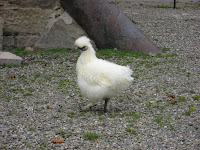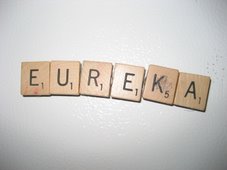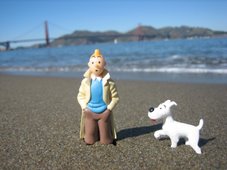Friday, September 28, 2007
What is a Lock? And how do they work?
Written by Sam & C:
A lock is a boat elevator that brings narrow-boats up or down a hill. A lock uses water to lift boats up or down like an elevator. Locks are needed because most boats cannot handle rapidly moving water. We know about locks because our family has been narrow boating and have used two locks: once up, and once down .We are giving an example of how to a pilot a boat down hill using a lock.
To explain how to operate a lock we will give you this excellent procedure. A lock is mostly a channel with gates at each end. It also has valves at each gate to let the water in and out. This procedure explains how to move a boat downstream through a lock. If the upper gate is closed, then close the lower gate and open the upper gate valves to fill the lock. Then open the upper gate. Once the upper gate is open, or if it already was open, drive in. Then close the upper gate and make sure the upper gate valves are closed. Open the lower gate valves to lower the boat and then close the lower gate valves. Open the lower gate and drive the boat out.
Locks are important because they move boats up and down hills. Canals were used to bring goods out of the hills and locks were used to bring boats in and out of the hills.
[The photo of the boat stuck in a lock was one we saw in the paper. It sunk when part of it got stuck in the lock, allowing the front to tip down into the water and fill up.]
Our Walk to, from, and around Chirk Castle, including inside it
C: We walked up to
Then we went to the Tea Room, and the scones were really good when they had butter and jam on them, but the tea was a little too strong. The room was an old place, and the wing that we were in had some old tub with some thing on the top, and two faucets. The room was inside the castle, so I guess we were pretty lucky to be able to eat scones and drink tea inside a 700 year old castle in eastern
We went on a tour, and there was a bunch of roped off old furniture, and candle things, and dishes and chandeliers and stuff. It was actually kind of interesting. And there were a bunch of paintings on the walls, and each had numbers, and you looked at the paper in each of the rooms that told you what they were. They were mostly portraits with ruffs around their necks. I don’t know how they could stand it, it must have been uncomfortable.
Then, we went to the family room and tried on a whole bunch of costumes of rich people, and there was a hat that was actually of the Gold Rush time-period style. In the first room there were shields. After we went to the family room we went to one of the towers, and there was even more dress-up stuff, and I dressed up in a leather jerkin and an odd hat.
The dungeon had a dirt floor, and on the dungeon staircase was a lower guard’s room. I think Sir Thomas had it good. He had a nice big room in the top of one of the towers. In fact, I got to run around the room.
On the way there and back, we walked through a bunch of pastures where cows and sheep live, and along the fence there was a lot of wool stuck in the wires, so we picked it off, and by the time we got to the boat, we each had a considerable amount of it. Loads of it was full of poop, and we decided it wasn’t worth it. The clean stuff we kept.
Towns so small, they aren’t even in the Frommer’s book
Mom: One of the benefits, I thought, about choosing to take a narrowboat trip in a rural area like this, was being able to see the small towns, and meet the real people and see how they live. Our guides for this trip have been a couple of narrowboat guidebooks I purchased on Amazon
[Note: On the way back, we spent another night in Chirk and expanded our view of the town. The Bridge Inn was very accomodating, and we improved our education of ale definitions, thanks to the friendly bartender. And our adventure to Chirk Castle was well documented by the boy in the next post! The walk up to it was a real highlight of the trip for me, through cow and sheep pasture, past old houses, but with views of the cadbury chocolate plant, and the lumber mill.]
If you are looking for the best meat pies or pasties, skip the bakery, and head to the butcher shop.
The markets in the small towns, unlike in the US, have very reasonable prices on goods, it does not appear that a mark-up is added to take advantage of the "captive" customer base.
Lots of stores have signs reminding people to bring their own bags to save the environment, but we didn't see anyone doing this, and when we brought out our own bags, cashiers seemed to act like it was out of the ordinary.
We didn't spend much time in large cities, but we didn't see any large strip malls or mega-stores at all, with the exception of Tesco, which is like a super-store grocery store selling all sorts of food and dry goods. Evidence of Ikea was apparent all over Paris, and certainly in the apartment we rented and the place we stayed on the coast.
Its hard to get a good cup of coffee in the UK, although there are Starbucks in London & Paris. The kind of coffee we are accustomed to is called "filter coffee". If you order a coffee at most places, you'll get what we call an "Americano". In the hotel rooms (in the UK, we didn't stay at any hotels in France), you'll find an electric water kettle instead of a coffee maker.
We prefer tea, so we did quite well, thank you, however, most all places serve tea for sit-down only, and the few times we were in a hurry, we ended up going without.
Food was very expensive when we ate out, especially in tourist areas. By shopping and cooking for ourselves, we kept the food expenses reasonable. If it wasn't for the exchange rate, prices would be cheaper here than in the Bay Area (considering a 1:1, or even a 1:1.50 exchange, which hasn't been seen in a couple of years).
In the back of an electronics store in Ellesmere, we were able to plug in the laptop and access the internet, as well as have an interesting conversation with the proprietor.
All of these towns have many older brick commercial and residential buildings, and an ageless feel to them. Well tended yards and public areas. Not much litter or blight, which is not the case in the larger cities. And the prices of most goods seems lower. The food in, general, has been good, with lots of fresh choices, if a bit heavy.
Snips and Bits from the Last Week
Sam: Whistling, Kids Screaming
When we got on the train and the whistle started, kids screamed and it broke my eardrums!
C: Today, Mom got me a glider and two parts of the front broke, but I fixed it with tape, and it’s a good toy.
Sam: As we were riding, we passed mom and dad duck with 10 or 11 little ducklings. They were brown, black and brown with blue. Then later when we stopped, we saw the Dad and I opened the window and saw them outside and Mom actually picked one up. When they jumped up to get bread you’d think their beaks would bit and pull, but it didn’t, it was just like opening your hand and doing the jabbering sign and it felt the same.
Tuesday, September 25, 2007
Aquaducts, Viaducts & Tunnels; 15 Miles on the Llangollen Canal
Dad: On Friday 21 September we started our one-week narrowboat holiday on the
Our boat, the Saffron, is seven feet wide and approximately sixty feet long. If you’ve ever driven a boat you will undoubtedly appreciate the enjoyment of piloting this beast on canals that range down to six inches wider than the boat. Most places are wider, but maneuvering around moored boats and traveling boats is challenging. Speeds are limited to 3 miles per hour and creating a breaking wake is forbidden. Kim and I share the captain and first mate roles. The boat has all the comforts including the telly, but no internet.
The
The biggest attractions and technical wonders of the Llangollen Canal are the Pontcysyllte Aqueduct and Chirk Aqueduct both designed by Thomas Telford noted as the greatest civil engineer of his time in Britian. The aqueducts are constructed of welded cast iron troughs supported by columns of locally quarried sandstone. The Pontcysyllte Aqueduct is 120 feet tall and 1,007 feet long and allows the canal to cross the
The Chirk Aqueduct is shorter in height and length, but a railroad viaduct constructed adjacent to the aqueduct and about 35 feet higher gives a striking experience of disorientation, scale and perception. The sense of height and vulnerability of being on the aqueduct, the imposition of the massive stone columns and arches of the railway viaduct, and the calm of the green pastures below is intensely otherworldly. Pictures can’t do it justice.
The canals also have hand operated locks and drawbridges.
Swans, Ducks, Geese & Ducklings
Sam: Gemima, Julia, Jamie, Jake, Amelia, Madeline, Jonathan, Jakey, Frapuccino, Toffee, Brownie, Jakers, Carmen SanDiego, Bleach, Whitey, Carmen, Zapper, Zip, Zakely, Zommy, and then there’s the twins, but we haven’t really named them yet. Oh yeah, those are Zippy and Zappy.
These are all of the ducks we’ve named. I think there’s a few more, but I forgot all of them. I think my favorite are the twins, and their mom and dad, Jakey and Frappucinno.
While we are on the narrowboat, a bunch of ducks follow us, and we feed them noodles and bread. One time some geese were sitting on the side, and then, there were swans. The swans were really funny, and they have really stubby feet. The swans followed us for about 2 miles, and then a boat passed us, and then mom told them “if you feed them, they’ll follow you” and then the swans turned around and followed them.
We went to Ty Mawr Country Park, near
Our Day in Llangollen
C: We drove the boat over to Llangollen, and then as soon as we possibly could, we got on the Llangollen railway, and went through a bunch of countryside, and the first long tunnel we went through was extremely unpleasant because there was smoke all over the place. It smelled like sulphur, because it was coal smoke. The train did not look unlike the Hogwarts Express. In fact, the only difference was that it was dark green instead of red, and it said Foxcoat Manor, instead of
Later, we went around town and went to an attic sale and I got a Weet-Bix truck, for 2 GBP. And then, for dinner, after walking around the town, we found a place that served us way too much. I had steak pie, K had chicken nuggets, Mom had Ploughman’s Lunch, and Dad had veggie lasagna.
And this ends our blog.
Saturday, September 22, 2007
Welsh Tooth Fairy
Wednesday, September 19, 2007
Bat-Sur-Mer Fun





Sam: I had three Eureka Moments today, so I am going to write about all of them on this one entry.
First, I would like to write about my jacket. Today I got a brand-new jacket. It is blue and white striped, with a red anchor on it. It also has a zipper and a hood. It is my favorite, because it looks nice, and it has an anchor, because we are going on a boat, and it keeps me warm.
Now I will write about the dogs. A lady was selling some puppies in the market. They were really cute. They were really playful, but they loved to lick. They were black and brown. That is the kind of dog I want to get when I grow up. They are yorkies.
Now, I want to write about the salt flats here. A long time ago, I don't know the exact date, the serfs used to work in the salt fields. They would let the water from the ocean sit for 1 to 1 1/2 years, then it would be dry salt, and they would rake it and sweep it up, and package it and sell it. On our way past there, we passed a roadside salt stand that sold the salt from the salt flats. At the creperie that we went to tonight, I tried some of the salt. It tastes really good.
THHHHE ENNNND
Tuesday, September 18, 2007
Shells, Shells & More Shells





C: We went to the beach and found a bunch of shells, and then we went to another beach and found a bunch more shells. Some of the shells were clam shells, and some were razor clam shells, and one of my razor clam shells must have been at least 7 inches long.
The beach had a lot of shells, and you couldn't walk around without breaking ten shells at once. Some of the shells were snail shells. One of the snail shells is my favorite, because it is all ridged and white.
We were there at low tide, and not very many people were there, except I saw one man running barefoot over the shells. It was almost nothing like the beaches in California, the only similarity was. . . SAND.
In Massachusetts there are similar beaches, because there are clam shells, AND sand, and there are similar shells. And when it gets to be low tide in Massachussetts, there are huge beaches, a lot like here in France.
The shells are the same here because all of the spores float to the other side of the ocean, I guess.
[Note from Mom: We are staying at a friend's house near Le Croisic, on the south coast of Brittany. It's just north of where the Loire river flows into the Atlantic, and is an area that has been known for its salt harvesting industry for centuries.]
Getting to the Coast- Driving in French




Ok, it might not have been the best idea to pick up the rental car in Paris.
With the maze of one-way streets, and over a half an hour of circling round and round, I finally took the drastic step of driving the wrong way, in order to finally get to our apartment to pick up the rest of the family.
Another 45 minutes or so, we drove around, trying to find our way out of Paris. Our assessment was that there were several things which made driving here more complicated. Obviously, the language, but also the street signs are sometimes covered up by cafe awnings, and they are posted on the buildings, only, not before the intersection. The intersections are often roundabouts (especially where many streets come together at once). Paris is not laid out on a grid, so its easy to lose your sense of direction. In short, it was foreign to us.
Then, another wrong detour to miss the toll road (again) and we ended up driving to Chartes on the rural roads. Which was pleasant, but took longer than we expected.
Chartres is the home of La Maison Picassiette, which is an amazing mosaic house, created by a resident of Chartres over a 30 year period, beginning in 1938. No photos are permitted but you can see more about it here: http://www.thejoyofshards.co.uk/picassiette/index.shtml This was a pilgramage for my mother, who has wanted to visit for years. This side trip, however, led to more getting lost.
Finally we got on to the tollway. The speed limit is 110. Kilometers per hour, that is. It still seems strange to see that on the dashboard.
Our car is a Citroen Picasso, automatic, diesel, which seats 7. Its smaller than our honda van, which seats 6, so with our luggage its a bit cramped, but still large compared to other cars on the road. It has an onboard navigation system, which clearly didn't help us much, and the manual is all in French.
We arrived on the coast very late, after dark, and spent about another hour trying to find our friend's house, and finally had to call for an escort. It was a long night!
Paris Metro





In Paris, we used the metro to travel around, when we weren't walking. The metro has many, many stops. We bought a pass called the Orange pass, and we had to bring our own pictures to put on it (you could buy them there, but they were 4 Euros each, so printing them out ahead of time saved us a lot of $$).
Sometimes it seemed like you were walking further underground than you would have if you just walked.
The trains came every 2-3 minutes.
The train was like a normal train-like-bus, says C.
The signs were Art Nouveau, cast metal, and were quite beautiful.





































